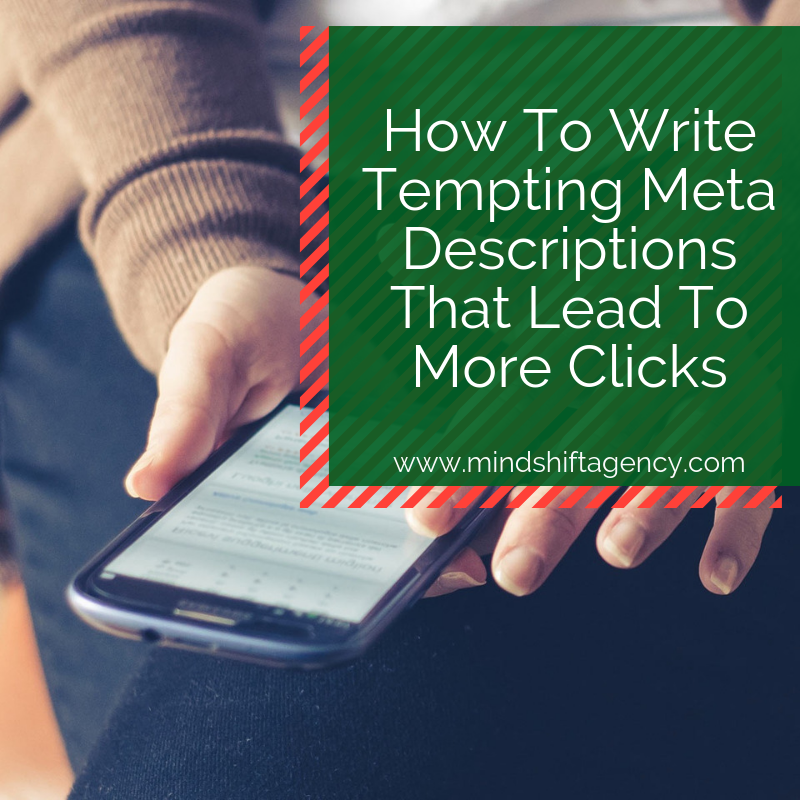How To Write Tempting Meta Descriptions That Lead To More Clicks
A few years ago Google increased its snippet length. Then it dropped it back down. Flip-flop, back and forth. Sometimes it feels like there are new guidelines every month for improved search engine optimization, and we’re continually scrambling to keep up. Lately we’re catching up on meta descriptions.
What is a meta description?
According to HubSpot, a meta description, also called a snippet, “is the brief snippet of text that appears below the blue link in a search engine result. This description summarizes the content of the webpage linked above it, and although it is not an official ranking factor in Google search results, it can be edited to encourage people to click through to the webpage.”
The new, improved, and longer meta descriptions
The majority of search engine snippets were 165 characters or less in 2017. They had to be succinct yet captivating, and they were listed for each landing page. On a Google search page, your meta description text was two or three lines long.
Then it boosted to 320 characters to achieve the same thing. Google tacked on an additional three or four lines to each description for landing pages, nearly doubling the meta description length!
Presently, your meta description shouldn’t exceed 160 characters...or you’ll wind up with the unwelcome ellipsis.
What longer meta descriptions mean for your business
What’s the big deal with potentially more characters and extra lines in snippets? Does this seemingly insignificant feature impact your business? Yes. Here’s why and how to catch up.
Why Your Click-Through Rate Matters
If you haven’t noticed this meta description improvement over the past year, it’s time to check out your click-through rate. A lengthened snippet could be positive or negative for your users, and those metrics will reveal which side your website visitors fall on.
For basic information, an enhanced snippet could be a negative thing. A user enters a simple question into the Google search engine, and your detailed description answers their inquiry. They have no need to click your link for more knowledge. No page visits for you.
This is especially harmful for websites that rank lower on the search list. Longer meta descriptions mean fewer websites fill up the search pages, especially on mobile inquiries. If you’re on the first Google search page but rank ninth or tenth, you may see a decline in your click-through rate.
On the opposite end of the spectrum, a longer snippet could be positive for your business. What about when a reader asks a more thorough questions, like “How do you write a meta description that boosts your click-through rate?” Your meta description could nearly provide the answer, while leaving out just enough to entice the reader to click the link and learn more.
How to catch up your meta descriptions
If you haven’t already reviewed and lengthened your previous meta-descriptions, it’s time! Aim for the sweet spot between 250 and 300 characters. You could possibly squeeze in 320 characters, but it’s best to avoid that (no one wants to see the snippet cut off with “…” at the end).
Diligently write a thorough snippet that offers a wealth of necessary information to the reader. Google will possibly rank your landing page higher because of your meticulousness. Answer the question your reader is asking without giving away all of your secrets. It’s a tricky balance that can be generously rewarded if done well.
A great way to do this is by summarizing your bullet points but not stating the meat of your article. That tempts the user with a sweet aroma but requires them to click the link to taste the treat.
Tips for writing a clickable snippet
The lingo sounds complicated, but the process is actually quite simple. Let’s pretend someone is searching for “How to write a meta description.”
- Include the keyword in your description. In this example, “how to write a meta description.”
- Answer their question but leave room for mystery. “There’s more than one way to write a meta description, but this method is the best.”
- Summarize your bullet points. “The perfect meta description is concise, direct, yet mysterious.”
- Link with related keywords, such as “snippet.” “The perfect meta description is a concise, direct, yet mysterious snippet.”
- Avoid unnecessary characters. This includes all non-alphanumeric characters. Skip the “&” symbol, “+” signs, and dashes. They are nonessential and make it appear like you’re trying to squeeze in extra information.
Waft your aroma
No matter your industry, updated snippets can improve your SEO. And in today’s digital age, your ranking directly impacts your current business and future success. Take the time to thoroughly review and improve your meta descriptions for all of your landing pages. Monitor your click-through rates and soar ahead of your competitors on Google.
Looking for a team who can transform you content into tempting meta descriptions? Our people are experts at summarizing your content into concise snippets that allure the reader to click for more information. Fill out the form below so we can transform and upgrade your meta descriptions together!

